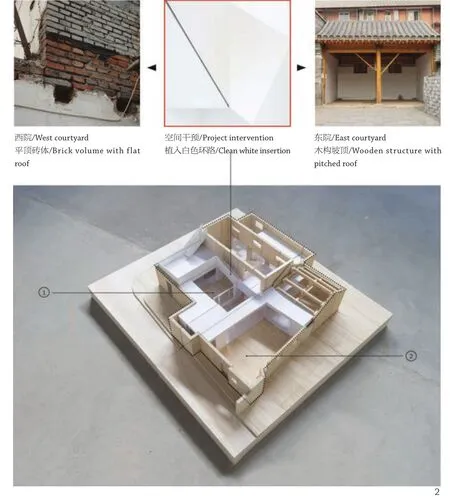互联院,北京,中国
建筑设计:临界工作室
Architect: reMIX studio
该项目位于历史悠久的白塔寺街区,是白塔寺院落更新的试点之一。业主希望通过此次改造项目,将宏大胡同33号的东西两个院落整合为一个集办公、沙龙、休闲为一体的新类型办公空间。场地现状中,西院(171m2现存一部近代砖构平屋顶,东院(98m2)则存在一部传统木构坡屋顶。
如何在整个场地形成一种连贯的场所体验而同时保持两个院落原本不同的材质属性,成为我们设计入手即面临的第一个关键问题。
我们的空间干预试图在两个院落迥异的材质和结构系统中植入一个连贯的“白色环路”:它不仅是串联砖木两种系统的介质,也是方案的动线骨架。这条环路在原有建筑结构的水平与垂直空间中穿梭,它本身去材质化的特征,使其得以以一种中性的姿态介入,并提供解读这部历史建筑的新线索:通过白色与木色,白色与红砖的材质冲突,定义了一种清晰的新旧之间的对话,也形成了不同空间独特的材质与氛围属性。
对于玻璃、金属网、穿孔板等具有不同通透性与私密性的材质的使用,在有限的空间中,创造了一系列微妙的层次。白色环路在两个院落形成了双环的构架,不仅实现了所有功能空间的室内连接,同时也将原本过于空旷而缺乏围合的两个院落转化为两个尺度宜人、气氛与材质不同的惬意庭院。它帮助将原先呆板平淡的空间分隔成一系列功能区域,并串联成一个收放有致的空间序列。传统僵化的功能分区被打破,取而代之的是一个边界更加模糊的活动综合体。这种开放式自由平面的格局,使得办公、谈话、讨论、休闲、聚会等活动可以轻松自由地发生。
它以楼梯、坡道串联了位于半地下、地面、夹层、屋面的高低错落的一系列室内外空间,形成一个不断变化材质与氛围的连续空间序列。院落原有的单一的室内外空间及两个院落之间彼此割裂的关系得以消解和重建,被转化为一个高差丰富、错落相连的动态空间系统。原本存在的屋顶平台也被纳入新的空间流线而得到激活与利用,成为俯瞰这片古老胡同的制高点。
项目信息/Credits and Data
业主/Clients: 北京华融金盈投资发展有限公司/北京金全嘉和投资管理有限公司/Beijing Huarong Jinying Investment Development Co., Ltd./Beijing Jinquanjiahe Investment Management Co., Ltd.
状态/Status: 待建/To be Construction
类型/Type: 改造/Renovation
功能/Program: 办公空间/Working Space
规模/Size: 建筑 200m2,景观 130m2/Interior 200m2,Gardens 130m2
团队/Team: 陈忱,Nicola Saladino, Alexandre Braleret,吕守拓,陈牧之,王翊人,陈思,陈宇轩,王萌萌,刘雨梦,张弥,李欣,陈鑫星/CHEN Chen, Nicola Saladino,Alexandre Braleret, LYU Shoutuo, CHEN Muzhi, WANG Yiren, CHEN Si, CHEN Yuxuan, Maggie Wang, LIU Yumeng,ZHANG Mi, LI Xin, CHEN Xinxing

1 设计过程/Design process

2 设计过程/Design process

3 改造后首层平面/Ground floor plan after renovation

4 改造后二层平面/First floor plan after renovation
The project is located in the historic neighbourhood of Baitasi as one of the pilot project for the Baitasi Renovation Project. Our client intended to reunite the two courtyards of Hongda 33 and transform them into a new type of working space, including meeting rooms, open spaces, leisure areas and lecture room. The site is rather challenging as it encompasses two existing buildings with distinctive features and architectural styles: the first building on the west courtyard (171m2) is made of brick walls with a flat roof whereas the second building on the east courtyard (98m2) is a more recently built shelter with traditional wooden structure and sloping ceramic roof.
With this in mind, our main goal was to design a coherent space where the speci fic nature of each existing building would blend with our intervention whilst creating a homogeneous experience with moments of contrast. This intervention took the shape of a white loop that stitches together two buildings with different materials and different structural systems.
The loop evolves both horizontally and vertically through what was once a divided environment and becomes the dynamic framework of the scheme. By twisting itself in a double-ring structure over the two courtyards and taking the shape of stairs, ramps,balustrades, mezzanine or roof, the loop not only provides the required connetions of all added spaces but also transforms two unused and oddly proportioned courtyards into a single space at a more human scale.
Its dematerialised nature enables it to intervene in a neutral way and to redefine a clear dialogue between the old and the new through a series of striking moments where it cuts through a rough brick wall or levitates underneath a wooden beam,perpetually reinventing combination of textures and forming unique atmospheres for each space.
In order to make the best out of the relatively small footprint of the site, a traditional and rigid office partition system was replaced by a more dynamic open plan with blurred boundaries where work, group activities, casual conversations and other gatherings take place in a seamless way. By using materials such as glass, metal mesh and other perforated steel plates with different levels of opacity,a series of subtle demarcations between private and public areas are made possible in this limited space.
The two originally divided courtyards are now connected in a series of functional areas scattered on different levels (semi-recessed into the ground,at existing level and at a new second floor) with the existing rooftop transformed into an accessible platform where one can enjoy the quiet flow of people and whispers of this historic alley.

5 内景渲染图/Interior rendered views

6 内景渲染图/Interior rendered views
评论
青锋:在院落改造类型中,互联院的尺度是比较大的。200m2的建筑,130m2的花园,位于城市中心,这在中国当前的土地政策下,几近于奢侈。reMIX充分利用了这个条件,在不大的建筑中制造出极为复杂的层高与路径变化。纯粹主义的白色部分有效地避免了过度的错乱,在东侧小院中与既有建筑的材质与结构形成柔和的反差。相比起来,西院的处理似乎可以更为细腻一些。可能是已有的复杂性制约了其他元素的引入。或许权衡一下,空间简单一些,但是在材料、建构、光线与视景上再多一些微妙的考虑,将能够与东院更好地匹配。
思唯雅·兰泰里:这个由reMIX工作室提出的方案旨在将两个不同阶段、不同材料建成的院落重新统一起来。一边是非常简单的语言和材料,一边又是非常有趣的层级和体量的联系,二者之间的张力即该项目所展现出的内容。它以缝合所有组成部分的白色环路的形式重新阐释了院落的概念:通过扭曲成一个双环结构,它降至楼梯、坡道、夹层或屋顶,不仅提供了一种新与旧之间的对话,还维持了其传统的人体尺度。(庞凌波 译)
Comments
QING Feng: Among the courtyard renovations, the scale of Hongda No.33 is comparatively large. Given its location in Beijing's city centre, with 200m2of building area, the garden area is 130m2, this is near luxury under China's current land polices. reMIX studio fully utilised this condition, and created extraordinary complex level and circulation variations in the relatively small building.The puristic white part of the design effectively avoided excessive chaos. The materiality of existing building and the structure formed a subtle contrast in the east courtyard. In comparison, the treatment in the west courtyard could have been more delicate. This may be because the existing complexity limited the introduction of additional elements. If more balanced, the space could become simpler, but more consideration can be given to materiality, tectonics, light and view, so that it can be better coordinated with the east courtyard. (Translated by WANG Xinxin)
Silvia Lanteri: This space proposed by reMIX studio aims to reunite two courtyards made of very different phases and materials. The project is elaborated through a tension between on one side very simple languages and materials,and on the opposite an interesting articulation of levels and volumes. It reinterprets the concept of courtyards taking the shape of a white loop that stitches together all the parts: by twisting itself in a double-ring structure, it declines into stairs, ramps, mezzanine or roof, not only providing a new dialogue between the old and the new,but also keeping its traditional human scale.

图片来源/Sources:北京华融金盈投资发展有限公司,白塔寺会客厅,世界建筑,曾庆超,董雪,居民等

绘图/Drawing:思唯雅·兰泰里/Silvia Lanteri

